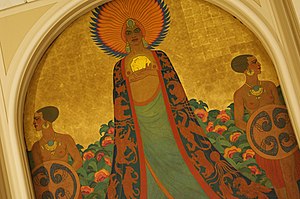Queen Calafia
| Calafia | |
|---|---|

Mural of Queen Calafia and her Amazons in the Room of the Dons at the Mark Hopkins Hotel, San Francisco, California
|
|
| First appearance | ca. 1500 |
| Created by | Garci Rodríguez de Montalvo |
| Information | |
| Gender | female |
| Occupation | Ruler of the Island of California |
| Title | Queen Calafia |
| Spouse(s) | Initially none, later she marries Talanque |
| Religion | Pagan, later Christian |
| Nationality | Californian |
Calafia was a warrior queen who ruled over a kingdom of Black women living on the mythical Island of California. The character of Queen Calafia was created by Spanish writer Garci Rodríguez de Montalvo who first introduced her in his popular novel entitled Las sergas de Esplandián (The Adventures of Esplandián), written around 1500.
In the novel, Calafia is a pagan who is convinced to raise an army of women warriors and sail away from California with a large flock of trained griffins so that she can join a Muslim battle against Christians who are defending Constantinople. In the siege, the griffins harm enemy and friendly forces, so they are withdrawn. Calafia and her ally Radiaro fight in single combat against the Christian leaders, a king and his son the knight Esplandián. Calafia is bested and taken prisoner, and she converts to Christianity. She marries a cousin of Esplandián and returns with her army to California for further adventures.
The name of Calafia was likely formed from the Arabic word khalifa (religious state leader) which is known as caliph in English and califa in Spanish. Similarly, the name of Calafia's monarchy, California, likely originated from the same root, fabricated by the author to remind the 16th-century Spanish reader of the reconquista, a centuries-long fight between Christians and Muslims which had recently concluded in Spain. The character of Calafia is used by Rodríguez de Montalvo to portray the superiority of chivalry in which the attractive virgin queen is conquered, converted to Christian beliefs and married off. The book was very popular for many decades—Hernán Cortés read it—and it was selected by author Miguel de Cervantes as the first of many popular and assumed harmful books to be burnt by characters in his famous novel Don Quixote.
...
Wikipedia
